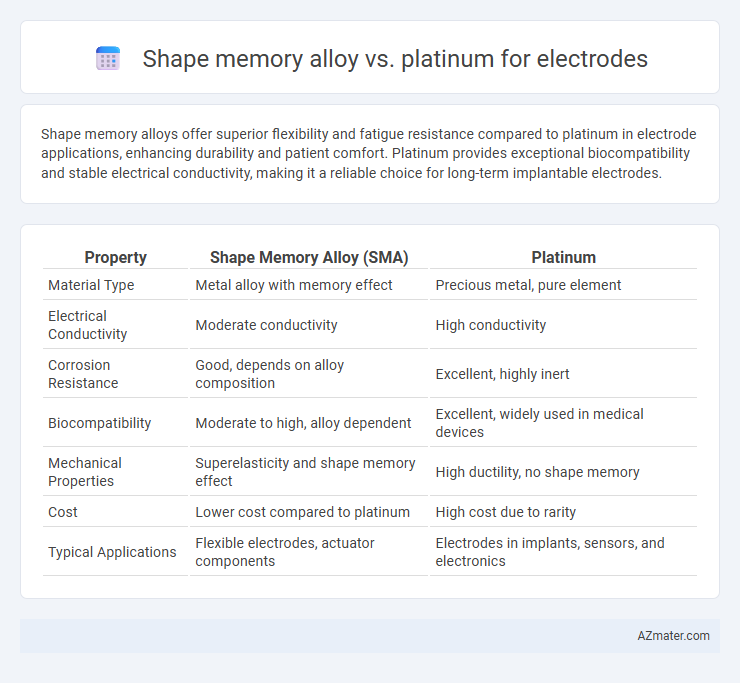Shape memory alloys offer superior flexibility and fatigue resistance compared to platinum in electrode applications, enhancing durability and patient comfort. Platinum provides exceptional biocompatibility and stable electrical conductivity, making it a reliable choice for long-term implantable electrodes.
Table of Comparison
| Property | Shape Memory Alloy (SMA) | Platinum |
|---|---|---|
| Material Type | Metal alloy with memory effect | Precious metal, pure element |
| Electrical Conductivity | Moderate conductivity | High conductivity |
| Corrosion Resistance | Good, depends on alloy composition | Excellent, highly inert |
| Biocompatibility | Moderate to high, alloy dependent | Excellent, widely used in medical devices |
| Mechanical Properties | Superelasticity and shape memory effect | High ductility, no shape memory |
| Cost | Lower cost compared to platinum | High cost due to rarity |
| Typical Applications | Flexible electrodes, actuator components | Electrodes in implants, sensors, and electronics |
Introduction to Electrode Materials
Shape memory alloys (SMAs) offer unique advantages in electrode applications due to their biocompatibility, flexibility, and ability to recover shape after deformation, making them suitable for dynamic environments. Platinum remains a gold standard for electrodes because of its excellent electrical conductivity, corrosion resistance, and chemical stability in biological and harsh environments. The comparison between SMA and platinum electrodes centers on balancing mechanical adaptability with long-term electrochemical performance.
Overview of Shape Memory Alloys (SMAs)
Shape memory alloys (SMAs) are advanced metallic materials capable of returning to a predetermined shape when exposed to thermal or mechanical stimuli, offering significant advantages in biomedical electrode applications due to their flexibility and biocompatibility. Unlike platinum, which is valued for its excellent electrical conductivity and corrosion resistance, SMAs provide superior mechanical adaptability and stress absorption, enhancing electrode durability and patient comfort. Their unique phase transformation properties enable dynamic conformability and reliable electrode-tissue interfaces, making SMAs a promising alternative in electromechanical biomedical devices.
Properties and Composition of Platinum Electrodes
Platinum electrodes exhibit excellent biocompatibility, corrosion resistance, and electrical conductivity due to their noble metal composition, making them ideal for long-term implantation and stable signal transmission. In contrast, shape memory alloys typically consist of nickel-titanium (NiTi) and offer unique mechanical properties such as superelasticity and shape recovery but may face biocompatibility and corrosion challenges in electrode applications. The dense atomic structure and chemical inertness of platinum provide superior durability and consistent electrochemical performance compared to the metallic alloys used in shape memory electrodes.
Electrical Conductivity: SMA vs Platinum
Shape memory alloys (SMAs) typically exhibit lower electrical conductivity compared to platinum, with SMAs conducting around 1 to 6 million S/m, while platinum offers approximately 9.4 million S/m. The higher electrical conductivity of platinum ensures more efficient signal transmission and reduced energy loss in electrode applications. Despite SMAs' functional advantages like flexibility and actuation, platinum remains superior for electrodes requiring optimal electrical performance.
Biocompatibility Comparison
Shape memory alloys (SMAs) and platinum are commonly used materials for electrodes, with biocompatibility being a critical factor in medical applications. SMAs, such as nickel-titanium (NiTi), offer excellent flexibility and are generally biocompatible but may pose risks of nickel ion release, potentially causing allergic reactions or tissue inflammation. Platinum electrodes exhibit superior corrosion resistance, minimal ion release, and excellent biocompatibility, making them a preferred choice for long-term implantation and reducing adverse immune responses.
Mechanical Flexibility and Durability
Shape memory alloys (SMAs) exhibit superior mechanical flexibility compared to platinum electrodes, enabling them to withstand extensive deformation while returning to their original shape, which is critical for implantable and wearable devices. Platinum, known for its high corrosion resistance and biocompatibility, offers excellent durability but is prone to mechanical brittleness and fatigue under cyclic loading. SMAs balance flexibility and durability by combining elastic deformation capabilities with good corrosion resistance, making them promising for applications requiring repeated mechanical stress without compromising electrode performance.
Corrosion and Oxidation Resistance
Shape memory alloys (SMAs) exhibit excellent corrosion resistance due to their ability to form a stable oxide layer, yet platinum outperforms SMAs with superior resistance to both corrosion and oxidation under physiological and harsh environmental conditions. Platinum electrodes maintain long-term stability and biocompatibility by resisting electrochemical degradation and oxidation better than most shape memory alloys, making them ideal for biomedical and electrochemical applications. While SMAs provide functional benefits like flexibility and shape recovery, platinum's inert nature ensures unparalleled durability and minimal corrosion impact in electrode use.
Cost and Availability of Materials
Shape memory alloys typically offer lower material costs and greater availability compared to platinum, which is a rare and expensive precious metal. The abundance of nickel, titanium, or copper used in shape memory alloys ensures more consistent supply chains and reduced price volatility. Platinum electrodes, while highly effective in conductivity and corrosion resistance, face significant cost and sourcing challenges limiting widespread use in budget-sensitive applications.
Application Suitability: Medical and Industrial Uses
Shape memory alloy electrodes offer superior flexibility and biocompatibility, making them ideal for dynamic medical implants and minimally invasive surgical tools. Platinum electrodes excel in corrosion resistance and electrical conductivity, ensuring reliability in long-term medical devices and harsh industrial environments. The choice between shape memory alloys and platinum depends on specific application demands such as mechanical stress tolerance, electrical performance, and environmental stability.
Future Trends in Electrode Material Innovation
Shape memory alloys (SMAs) offer promising adaptability in electrode design due to their unique ability to undergo reversible deformation, enhancing electrode flexibility and durability compared to traditional platinum electrodes. Future trends indicate a shift towards integrating SMAs with nanostructured coatings and biocompatible composites to improve electrical conductivity and reduce cytotoxicity, addressing the limitations of platinum's rigidity and high cost. Research increasingly targets hybrid materials that combine the shape-memory effect with platinum's excellent electrochemical stability, aiming to create next-generation electrodes for biomedical implants and flexible electronics.

Infographic: Shape memory alloy vs Platinum for Electrode
 azmater.com
azmater.com